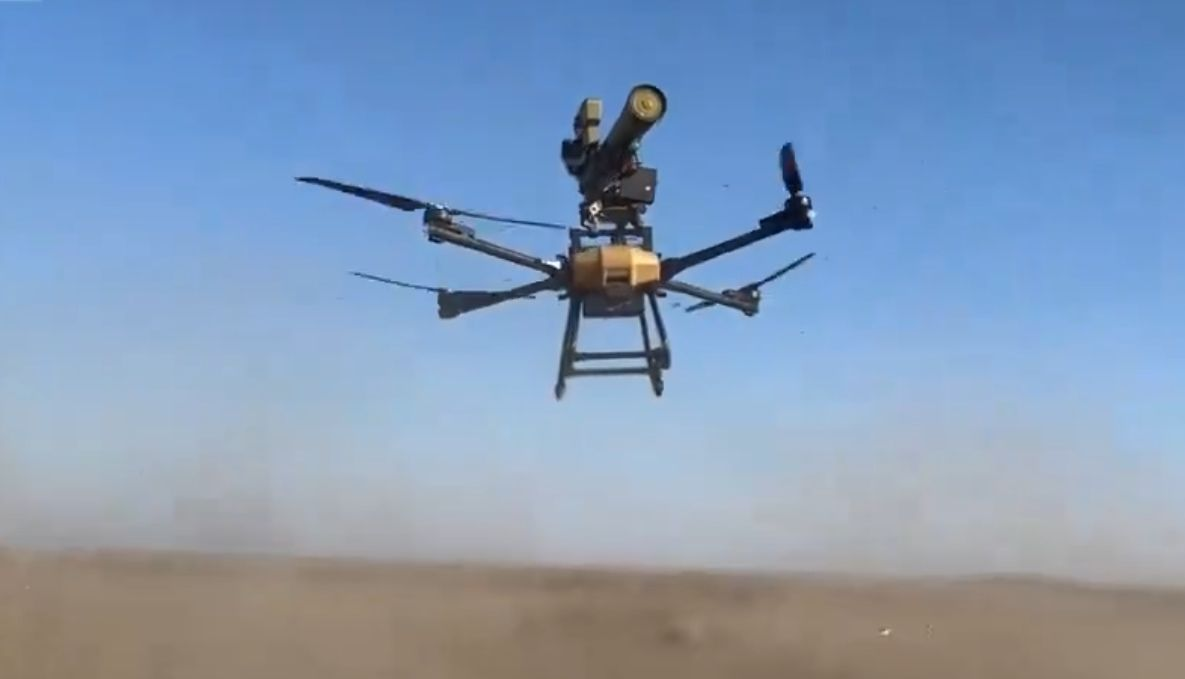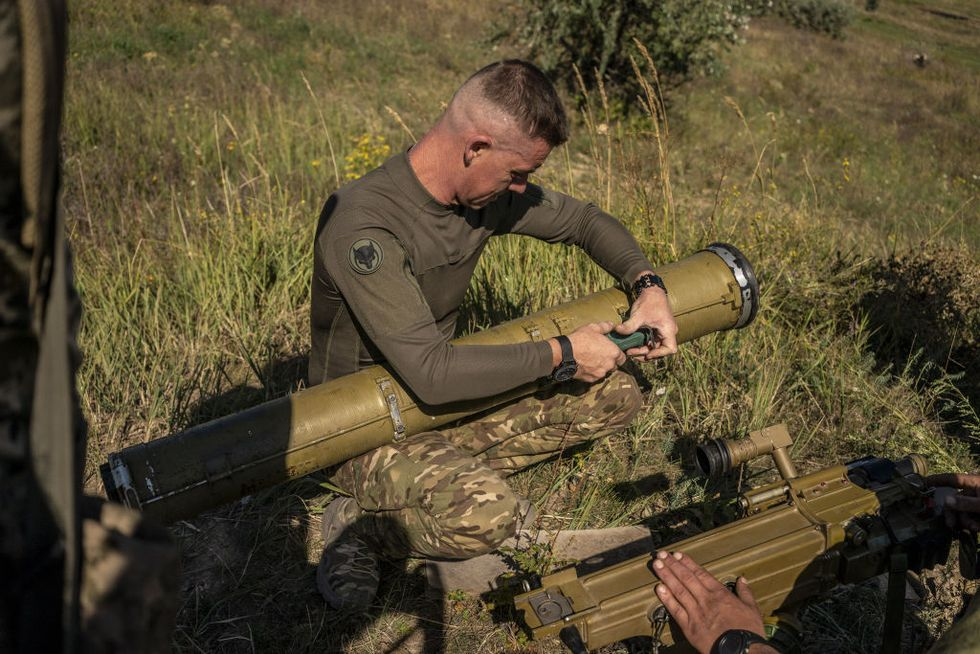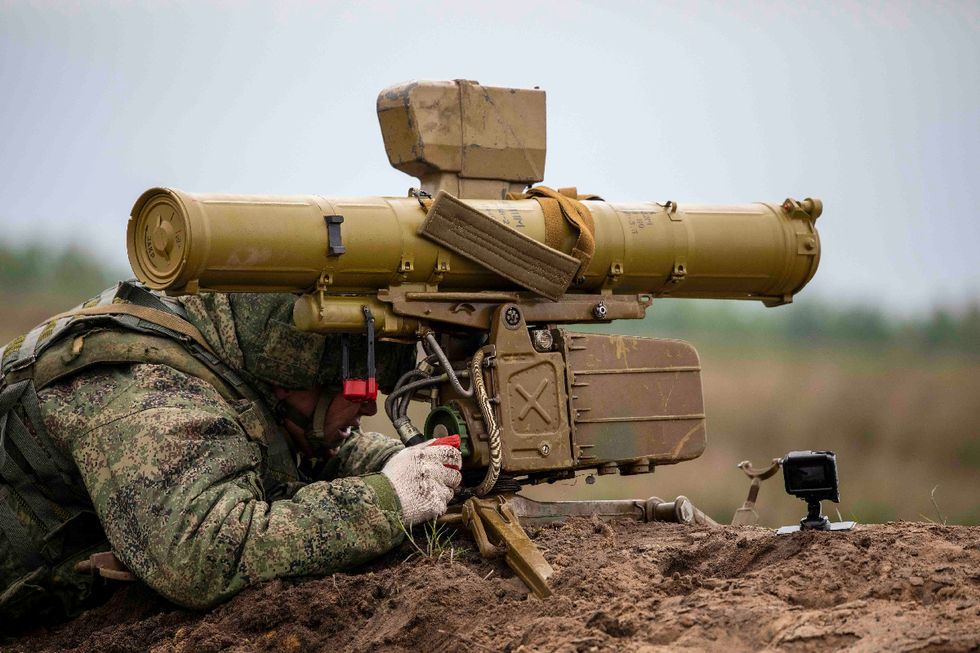F-35A Lightning II stealth fighters will now be considered “dual-capable” platforms useable in both conventional and nuclear warfare.

The U.S. Air Force’s F-35A Lightning II stealth fighters are now certified for delivery of B61-12 nuclear gravity bombs—and, in fact, have been since October 12, 2023.
This bombshell—dropped by F-35’s Joint Program Office (JPO)—was reported by Breaking Defense Friday morning. JPO spokesman Russ Goemaere stated that the certification had actually been awarded months earlier and far ahead of schedule.
This means that F-35As will now be considered “dual-capable” platforms useable in both conventional and nuclear warfare—in the latter role carrying up to two B61-12s internally and using its suite of ground-scanning sensors and datalinks to target the bomb more precisely than other B61-delivering aircraft.
Furthermore, while the U.S. Air Force has long operated conventional F-15E and F-16 fighters with the necessary ‘N-wiring’ to employ nuclear weapons, the F-35A is the first ever stealth fighter equipped as such.

Unlike the Air Force’s older air-to-air combat-oriented F-22 Raptor stealth fighter, the F-35A was always intended to assume the tactical nuclear strike capability of the F-16 fighters it was meant to replace. However, implementation of that capability—with the requisite wiring and datalinks to use the advanced features of the new B61-12 nuclear gravity bomb—was associated with an extensive (and highly expensive) upgrade program known as Block 4.
The certification award means that development and testing of the B61-12 capability is finally complete and deemed satisfactory after “10+ years of intense effort,” according to Goemaere.
Furthermore, the Air Force has stated that nuclear-capability is reportedly not dependent on receiving the full Block 4 upgrade package, and that the certification will be applied to “all” F-35As in the Air Force’s inventory. However, the F-35 isn’t certified for older B61-3 or B61-4 non-strategic bombs being replaced by the B61-12.

An F-35A drops an inert B61-12 bomb known as the Joint Test Assembly in a trial drop in October 2021.
Now the Air Force has a much more survivable way to deliver its arsenal of tactical nuclear gravity bombs, thanks to the F-35’s ability to penetrate enemy airspace at lower risk of being detected in advance and coming under effective fire from ground-based air defense missiles. The F-35 is also only the second fighter (following the F-15E) to be specifically compatible with the B61-12, which has much greater precision and range than its predecessors (see below.)
While stealth is not strictly impenetrable—there are tactics to combat stealth fighters—a stealth fighter has dramatically greater odds of both reaching its target to deliver a gravity bomb and making it back to base than a non-stealth fighter, which will assuredly be detected from much further away (unless enemy radars have already been thoroughly suppressed).
The Air Force already operates the B-2, a long-range nuclear-capable stealth bomber that began operational use of the B61-12 in December 2023. It is also rapidly moving forward with production of its successor the B-21 Raider, which first took flight last November. Furthermore, the service formerly operated F-117 Nighthawk jets capable of dropping B61 nukes. But the F-117 was never actually a fighter, despite the ‘F’ in its designation, as it could only drop bombs and had no air-to-air capability whatsoever.
Lastly, Popular Mechanics previously reported on possible hints China may be studying a nuclear attack capability for its J-20 stealth fighters. Past speculation that Russia’s Su-57 stealth fighter could serve in a nuclear role has yet to be substantiated, and seems unlikely at present, given the type’s very limited production and operational usage to date.
It’s also worth noting that the U.S. shares roughly 100 B61 tactical nuclear bombs with NATO allies Belgium, Germany, Italy, The Netherlands, and Turkey. And all but Turkey are adopting F-35As with the potential to deliver nuclear weapons, replacing their F-16 or Tornado jets in that role. However, that will be affected by the pace at which the older B61s in Europe are replaced with new B61-12s.
Nuclear arms control expert Hans Kristensen noted that a U.S. F-35 fighter wing based at Lakenheath in the United Kingdom is almost certainly to be equipped for B61-12 delivery, based on an accidentally posted contract for construction of shelter facilities in support of a ‘nuclear mission.’
The B61-12 and F-35 combo
The B61-12 is an expensive refurbishment of older B61s that dramatically improves their capability by introducing maneuvering tails fins, spin-stabilizing rockets and both inertial and GPS guidance. That transforms it into a glide bomb that’s both extremely precise and can fly up to an estimated 15 miles (if launched at maximum altitude).
In the video below of a B61-12 test, note how the bomb is stored in an internal bay so as not to disrupt the F-35’s stealth geometry. Also note the ignition of the spin-stabilizing rockets at the 29 second mark.
Improved precision makes it far more likely that a B61-12 will knock out a hardened nuclear weapons facility with one hit. And even its modest standoff range makes the weapon much more survivable for those carrying fighters on board to employ than a traditional gravity bomb. Those more traditional models are dropped directly over a target, which puts the aircraft at greater risk to air defenses and even to falling victim to the blast of its own nuke.
This is true for stealth fighters, which grow detectable to infrared sensors and even radars at short distances. Furthermore, stealth fighters will be able to more safely fly at higher altitudes to leverage the B61-12’s maximum possible glide range.
The B61’s blast can be dialed in for an explosive yield as low as .3 kilotons or as great as 50 kilotons. For comparison, the Little Boy nuclear bomb dropped on Hiroshima, Japan had a yield of 15 kilotons.
A higher-yield B61-13 with a blast dialable to 360 kilotons is under development and slated for limited production. It will combine the new features of the B61-12 with the earth-penetrating characteristics of the specialized B61-11 bunker-buster variant, but will be reserved for bombers and not be integrated into the F-35.
The U.S.’s 230 B61 tactical nukes are fewer in number than its long-range strategic nuclear missiles—and, being gravity bombs, they are not configured for easy and prompt standoff delivery, as compared to a cruise or ballistic missiles.
Even a limited use of nuclear weapons could have awful consequences. But fortunately, the post-World War II taboo against nuclear weapons use remains powerful, and any nuke—even supposedly ‘tactical’ ones—would likely only be employed as a last resort. The tactical arsenal’s role is primarily to deter other states from the use of their own tactical nukes under the (likely foolish) perception there are fewer risks of using them. Russia in particular has over 1,800 non-strategic nukes, and may see threatened or limited use of these weapons as a viable strategic option to stave off defeat.
While ‘tactical’ nukes sometimes refers to the concept of use against battlefield targets, that’s less likely to be how the U.S. Air Force would use them. Instead, they would most likely be employed against enemy nuclear or chemical weapons facilities and associated command-and-control systems in retaliation for a nuclear attack, or (more controversially) in preemption of an imminent one.
Even then, as the U.S. already has non-nuclear bunker-buster weapons effective against hardened weapons facilities, nukes might only be resorted to when facing an extensive number of possible WMD launchers that could not be suppressed fast enough using conventional strikes.
The F-35’s nuclear capability had aroused complaints by local groups opposing new F-35 bases, particularly in Vermont, on the basis they will influence the nuclear targeting plans of Russia and China. There’s a layer of ambiguity, as the Pentagon does not disclose which of its fighters squadrons are trained and equipped for nuclear delivery missions. However, one should bear in mind that there were already hundreds of nuclear-capable F-15 and F-16 non-stealth fighters dispersed in bases across the United States, so the F-35 does not present a novel risk in that regard.
.
Russia Test Launched a Big Anti-Tank Missile From a Civilian Drone

But can they guide it to target?
Civilian volunteers on both sides of Russia’s invasion of Ukraine have furiously worked to adapt hundreds of thousands of commercially available drones for combat use by soldiers on the frontline. And along the way, they’ve innovated to deliver more effective weapons—Ukrainians have taken the lead in both fielding drone boats and mass-producing cheap, first-person-view (FPV) kamikaze drones.
Russian volunteers, however, are trying to one-up their rivals by fielding a large anti-tank guided missile—a weapon that many drones would struggle to even lift, and which generates considerable recoil.
The weapon in question is an old 9M111 Fagot (“Bassoon”) wire-guided anti-tank guided missile—also codenamed AT-4 Spigot by NATO—which weighs 28-pounds, including its launch cannister and gas booster.

While the ordinarily 50-pound 9K111 launcher is missing its 9P135 tripod launch post, the 9S451 guidance box is visibly still attached, as is its 10x magnification 9Sh119 sight (which adds substantially more weight). This is a heavier payload than most of the civilian drones used in the war can accommodate.
The volunteers slung the launcher on top of a heavy-duty Perun-F quadcopter drone (not to be confused with a Ukrainian drone of the same name), described as a “heavy assault quadcopter.” According to a Greek drone analyst, it appears to be based on the Chinese EFT Z50 agricultural spraying drone, which can carry up to a 110-pound payload and is currently being sold for prices ranging from $7,000 to $10,000 USD.
The Z50 weighs 100 pounds (including batteries), has the endurance to hover for 7 minutes while carrying a maximum payload and 20 minutes unloaded, and is controlled via a remote control device with a 5.5” screen and range of 1.86 miles.
The video shows the Perun-F lifting off, achieving a semi-stable hovering state, and firing the powerful 120-millimeter diameter missile—despite the powerful kickback from the gas-generator, which propels the missile from the tube at 180 miles per hour.
The drone is also shown to be capable of firing while landed, which could be useful for setting up an ambush from an unexpected position. This capability likely explains why the missile is mounted atop, not under, the drone.
After launch, the missile’s solid-fuel rocket motor ignites, accelerating the missile to 420 miles per hour—roughly the maximum speed of many a late World War II fighter plane.
There’s a problem, though. The Basoon’s missile is ordinarily semi-automatically guided by a human operator to its target via a spool-out wire that stays connected to the missile throughout its flight. But there’s nobody “on” the drone peering through its sight and physically manipulating its controls. Without such direction, it’s basically just an unguided rocket that’s only likely to hit a very close target.
Drones and anti-tank guided missiles: feasible ?
Commercial drones have played an important role in anti-tank warfare in Ukraine. Initially, they were used to gravity-bomb armored vehicles from above with anti-tank grenades, and boasted surprisingly lethal accuracy. While this method is still used on immobilized or abandoned vehicles, by the winter of 2022/2023, it was surpassed by faster, remotely piloted first-person view drones used to ram enemy vehicles while carrying a contact-fused rocket-propelled grenade (RPG) warhead. These could better engage moving targets, and tens of thousands per month could be produced cheaply and quickly.

A First-Person View kamikaze drone with RPG warhead strapped underneath controlled by a Ukrainian operator named Sapsan near Orikhiv in southern Ukraine in September, 2023. Such FPV drones can be produced in huge quantities by civilian volunteers yet still deliver deadly precision strikes against armored vehicles.
Anti-tank guided missiles (ATGMs), however, are a different beast than rocket-propelled grenades. RPGs are cheap, highly portable, and have an effective range rarely exceeding a few hundred meters. ATGM systems, on the other hand, weigh dozens of pounds, typically have ranges of 1-4 miles, are more costly, and are guided all the way to target (which may take more than 30 seconds, depending on the weapon and distance.)
So while RPGs are close defense and ambush weapons, ATGMs are rarer, heavy weapons—they’re akin to long-distance snipers that can kill tanks. Furthermore, ATGM-launching helicopters have proven effective. They have superior mobility and vantage to locate and pick off enemy tanks, all while remaining outside the range of many short-range air defenses. So, the Russian ATGM-on-drone project could hypothetically result in a kind of poor man’s anti-tank helicopter.
But without guidance to hit targets at range, ATGMs lose most of their utility compared to RPGs. Furthermore, the 9K111 has a minimum range of 70-75 meters.
The design challenge is to make sure the drone’s operators have a way to both spot the target (preferably from a sight on the drone, parallel to the launcher), and to send guidance commands to the missile midflight in order to keep it on track. Stabilization of the sight used to guide the missile also appears necessary, given the observable wobbliness.
These are solvable problems—though, they are solvable in ways that may cut against either the DIY nature of the project or the drone’s maneuverability. For example, the operators might tether the drone to the missile’s original analog guidance system on the ground (while retaining a videofeed on the drone as a sight). Ukraine’s Stugna-P system, for example, already has a 50-meter cable tether, and such a tether has been improvised for Russian Kornet and 9K111 systems. Of course, that solution would largely remove the system’s mobility.

Or they could expensively devise a remote-control command link for the 1970s-vintage missile, but such bespoke innovations risk exceeding what DIY volunteers can reasonably achieve.
Russia’s newer ATGMs—notably, the larger 9M133 Kornet and lighter 9M131 Metis-M—are laser-beam riding weapons, in which a laser on the launch platform transmits guidance instructions to the missile by reflecting a laser into receivers on the missile’s tail. Those guidance systems might be easier to adapt for remote control, and those weapons also penetrate two or three times the equivalent armor of the original 9M111 model.
It’s noteworthy, though, that the testers used the Bassoon—an over 50-year old weapon—which lacks the penetrating power to reliably defeat the bricks of explosive reactive frontal armor on most Ukrainian tanks. Given the demand for ATGMs on the frontline, perhaps the testers reason that a volunteer-built anti-tank drone will only be able to use older munitions.
A Western-style fire-and-forget missile like Javelin, or one with built in radio data-link like Spike, would simplify the problem—but it isn’t an option for the Russian volunteers.
How anti-tank missile-armed drones could work
A conservative operational concept for drone-launched ATGMs could see these used as stand-ins for the usual ground-based ATGM teams being priority targeted by artillery and armored vehicle cannons. While remaining close to friendly positions, ATGM drones would offer better spotting angles, firing angles, and a degree of mobility—all while sparing human operators from enemy counter-fire (and thus reducing hesitancy to open fire at all).
A more radical concept—reliant on better command-links and jamming resistance, and perhaps AI-assisted target ID and guidance algorithms—might seek to use these drones to infiltrate past the frontline, allowing them to take shots at a tank’s much weaker side and rear armor (which also may make it more likely to achieve surprise). The ability to land these drones and have them lay in wait to spring an ambush from the ground also has interesting tactical potential.
The inherent standoff reach of ATGMs would allow them to both safely strike more distant targets and engage tanks protected by self-defense jammers (which are increasingly common, due to the threat of kamikaze drones). Furthermore, many non-tank assets behind the frontline could be attractive targets, such as command posts, radar systems, supply trucks, communication systems, ammunition depots, and jamming systems.
But before either concept can be implemented, the problem of guidance must be solved.
Samuel Bendett, an expert on Russian unmanned systems and AI at the technology, told Popular Mechanics that he sees the promise of such systems. “That recoil is going to be very powerful, stabilizing this kind of drone can be difficult and and getting an accurate strike can be problematic,” he said. “But if you are looking for a less accurate airborne hit, then this can potentially be appealing.”
This content is imported from x. You may be able to find the same content in another format, or you may be able to find more information, at their web site.

Schreibe einen Kommentar
Du musst angemeldet sein, um einen Kommentar abzugeben.